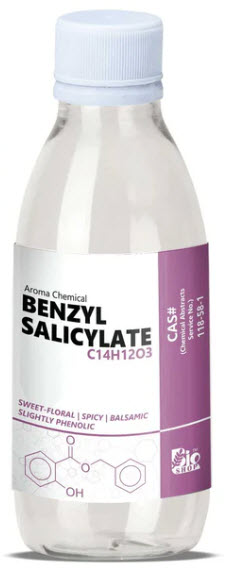Benzyl Salicylate: An Aroma Chemical in Perfumery
Benzyl salicylate is a widely used aroma chemical in the fragrance industry, valued for its pleasant, sweet, and balsamic scent. It is a key ingredient in many perfumes, cosmetics, and personal care products due to its versatility, stability, and ability to blend well with other fragrance components. Below is a detailed explanation of benzyl salicylate, including its properties, uses, and significance in perfumery.

1. Chemical Structure and Properties
- Chemical Name: Benzyl salicylate
- IUPAC Name: Benzyl 2-hydroxybenzoate
- Molecular Formula: C₁₄H₁₂O₃
- Molecular Weight: 228.24 g/mol
- Appearance: A colorless to pale yellow liquid.
- Odor: Sweet, floral, balsamic, and slightly musky with a soft, powdery undertone.
- Solubility: Insoluble in water but soluble in alcohol and oils, making it suitable for use in perfumes and cosmetic formulations.
- Boiling Point: Approximately 300°C (572°F).
- Stability: Stable under normal conditions but can degrade under strong acids, bases, or UV light.
2. Natural Occurrence
Benzyl salicylate is not commonly found in large quantities in nature but can be detected in trace amounts in some essential oils and plant extracts, such as:
- Ylang-ylang
- Hyacinth
- Tuberose
- Jasmine
However, the benzyl salicylate used in perfumery is typically synthesized in laboratories to ensure consistency, purity, and cost-effectiveness.
3. Role in Perfumery
Benzyl salicylate is a versatile fragrance ingredient with several key roles:
- Fixative: It helps stabilize and prolong the scent of a perfume by slowing down the evaporation of more volatile components.
- Blending Agent: It harmonizes and smooths out harsh notes in a fragrance composition, creating a balanced and rounded scent profile.
- Base Note: It is often used as a base note in perfumes, providing a long-lasting, soft, and balsamic foundation.
- Floral Enhancer: It enhances floral notes, particularly in white floral fragrances like jasmine, gardenia, and lily.
4. Fragrance Profile
Benzyl salicylate contributes the following olfactory characteristics to a perfume:
- Sweet: Adds a gentle, honey-like sweetness.
- Floral: Enhances floral accords, especially in white floral compositions.
- Balsamic: Provides a warm, resinous, and slightly spicy undertone.
- Powdery: Imparts a soft, velvety texture to the fragrance.
- Musky: Adds a subtle, skin-like warmth.
5. Common Uses in Perfumes
Benzyl salicylate is a staple in many fragrance families, including:
- Floral Fragrances: It is a key component in floral perfumes, particularly those featuring jasmine, gardenia, and tuberose.
- Oriental Fragrances: Its balsamic and sweet qualities complement the warm, spicy, and amber notes in oriental perfumes.
- Chypre Fragrances: It adds depth and softness to the mossy, woody, and citrusy accords in chypre compositions.
- Powdery Fragrances: Its powdery character makes it ideal for soft, musky, and skin-scented perfumes.
6. Safety and Regulation
Benzyl salicylate is generally considered safe for use in cosmetics and fragrances when used within recommended concentrations. However, it is regulated due to its potential to cause skin sensitization in some individuals. Key points include:
- IFRA Compliance: The International Fragrance Association (IFRA) sets guidelines for the maximum allowable concentration of benzyl salicylate in different product types to ensure safety.
- Allergen Potential: It is classified as a potential allergen in the EU, and products containing it must be labeled accordingly if it exceeds certain thresholds.
- Patch Testing: Perfumers and formulators often conduct patch tests to ensure it does not cause adverse reactions in sensitive individuals.
7. Advantages in Perfumery
- Versatility: It blends well with a wide range of fragrance materials, including florals, musks, and spices.
- Longevity: Its fixative properties help extend the lifespan of a perfume on the skin.
- Cost-Effectiveness: As a synthetic ingredient, it is more affordable than natural alternatives with similar scent profiles.
8. Limitations
- Sensitization Risk: It can cause allergic reactions in some individuals, limiting its use in high concentrations.
- Regulatory Restrictions: Compliance with IFRA and EU regulations may restrict its use in certain formulations.
9. Example Perfumes Featuring Benzyl Salicylate
Benzyl salicylate is found in numerous iconic fragrances, including:
- Chanel No. 5: Enhances the floral and powdery notes.
- Dior J’adore: Complements the white floral bouquet.
- Guerlain Shalimar: Adds warmth and sweetness to the oriental base.
10. Conclusion
Benzyl salicylate is a fundamental aroma chemical in perfumery, prized for its sweet, balsamic, and floral characteristics. Its ability to act as a fixative, blending agent, and base note makes it indispensable in creating complex and long-lasting fragrances. While it is generally safe, its potential as a sensitizer necessitates careful formulation and adherence to regulatory guidelines. Its versatility and affordability ensure its continued prominence in the fragrance industry.